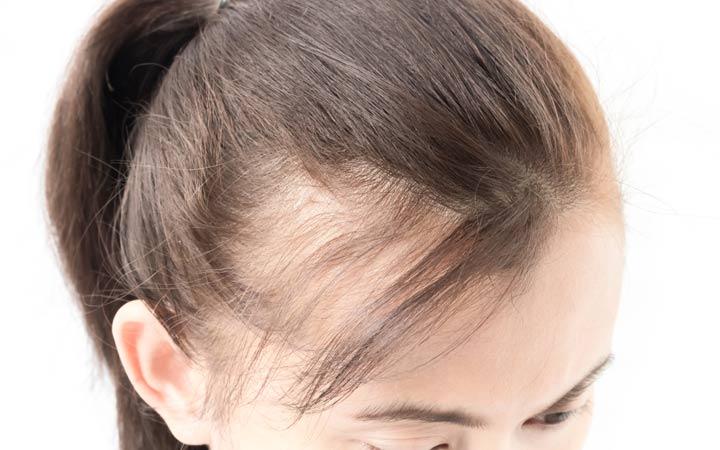It is normal for women to lose some hair every day. But when bald patches or thinning occurs, it may be because of female pattern baldness. This is because hair falls out every day. New hair grows to replace the hair that falls out. But if a woman has female pattern baldness, then new hair will not grow to replace the dead hairs on her head.

What is Female Pattern Baldness?
Female pattern baldness is a type of hair loss that only affects women. The name for the condition is androgenetic alopecia. Men and women may experience hair loss, but it is not as common in men. When female pattern baldness happens, there usually aren’t any bald spots or receding hairline. Instead, the person loses a lot of volume in their hair.
You May Also Like: Simple Changes to Your Diet and Lifestyle Can Help You Stop Losing Hair.
In women, the first signs of hair loss are usually in the part of their hair. Hair can feel thinner than usual. Although you may see the scalp, the hairline does not go back as it does for men. It will happen less often than for men too. Hair loss is more likely to happen when you get older and fewer women keep their full head of hair for a long time.
Genetics can help you know if you are more likely to have female pattern baldness. You can get the gene for this from a parent. Female pattern baldness often starts in women when they get older and at their midlife, but it may start earlier. Hormones may also play a role in this condition, so hormonal changes might be one reason why the condition starts later on.
Causes
Female pattern baldness may happen due to a person’s genetics. But it also may happen because of an underlying health condition that affects the production of the hormone androgen. Tumors in the pituitary gland or ovaries, which can produce androgen, can also lead to hair loss.
Other causes for hair loss in women are as follows:
- Autoimmune Disease: This is a rare disease that causes the immune system to attack the hair follicles and make them fall out.
- Medications: Some medications can lead to hair loss as a side effect. But if you stop taking these medicines, your hair will grow back.
- Illness: Hair loss can happen after an illness such as surgery or if you have a high fever for too long.
- Traction Alopecia: Some people may lose their hair from wearing hairstyles that pull too hard on their hair over time.
Treatment
Medication
One of the most common oral medicines for female pattern baldness is spironolactone. It helps hair grow and can help people who are losing their hair. However, this medicine can cause dry mouth, nausea, and dizziness. In addition, pregnant women should not take this medicine because it might cause disabilities in a baby before it is born.
Also, you can use Folexin. Folexin is a growth supplement that supports the healthy growth of hair and prevents hair loss. It is made up of natural ingredients.
Also Read: Best Hair Growth Products For Women & Men In 2021
Hair Transplant
Some women may choose to have a hair transplant. There are different ways to do this. Hair loss usually affects only some areas of the scalp. When you get a hair transplant, the doctor removes hair from an area with healthy hair growth and places it in the spot with no hair. The area from which you took your hair will not be affected by your baldness. You will be asleep during the procedure, and it takes many hours.
Laser Treatment
Some people may want to try at-home laser treatment for hair loss. These devices work by emitting low levels of laser light. Some research says that these low levels of laser light can stimulate hair growth in women and men, but other studies have not proven this yet. So it is important to do more research before deciding if this type of treatment will work for you or not.
Prevention
Female hair loss may be genetic. But there are ways to keep your hair healthy and prevent breakage and damage. You can do this by limiting treatments that cause hair damage, like perming, straightening, or hair extensions. It would help if you also ate a diet rich in protein, vitamins, and iron.
Protect your hair from the sun by wearing a hat or other head covering when you’re outside for long periods of time. Do not brush wet or fragile hair with a comb or brush because it will hurt your hair strands. Instead, use your fingers to gently separate the strands when you want to brush them out after a shower.
